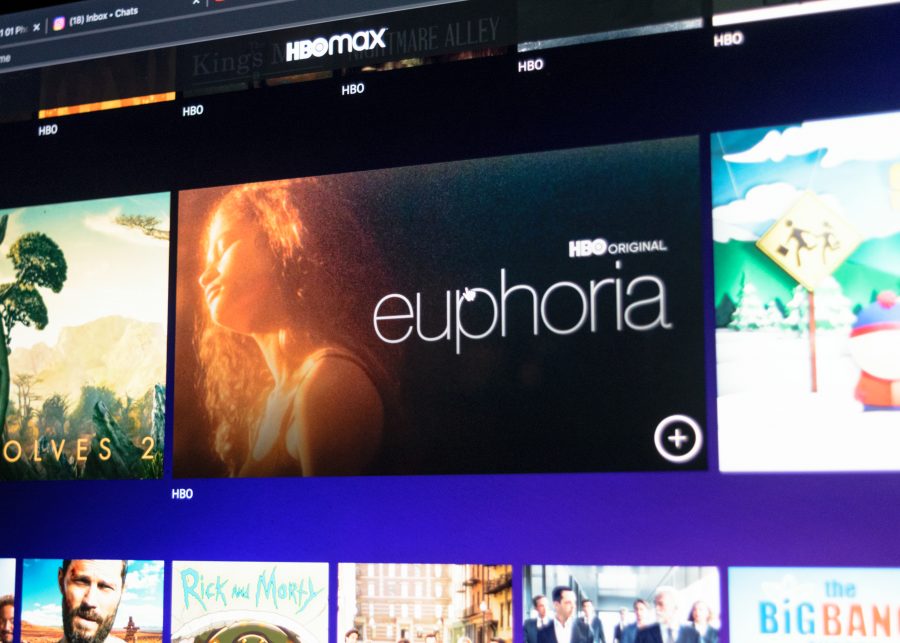Streaming services: the modern cable?
A UMass Boston student begins to stream “Euphoria” on HBOMax. Photo by Maya Martinez / Mass Media Staff
March 3, 2022
Between Netflix, Hulu, Disney+, HBO Max and Amazon Prime, plus new services, streaming platforms seem to be popping up almost every week. For some, this can be seen as beneficial, since many streaming services do not have advertisement breaks on them, and the ones that do are far shorter than traditional cable. However, for others it can be a costly investment. In the eyes of most people, though, streaming services are better than keeping cable; or are they?
At the beginning of 2022, Netflix announced that its price would increase yet again, this time to cost up to two dollars more a month. As Mike Murphy for MarketWatch said:
“Netflix […] subscribers in the U.S. will see the cost of the basic plan rising from $8.99 to $9.99 a month, while the standard (and most popular) plan goes from $13.99 to $15.49 a month, and the premium plan will jump from $17.99 to $19.99 a month” (1).
While this may not seem like a lot, especially if your lifestyle leans towards needing the premium plan and its ability to have four screens watch Netflix at the same time, this price jump can get pricey in combination with other services.
For instance, many students have Amazon Prime already, which not only gives them access to the fast shipping of the service, but also Amazon Prime Video for $7.49 a month (2). This deal is incredible, especially for college students on a budget; however, the next best deal that many students flock towards is the Disney+ bundle. For $13.99 a month, subscribers can get Disney+, Hulu and ESPN+ included in one payment. However, this version of Hulu is the base version of the platform, meaning there are still ads and it lacks the Live TV option. In order to still keep up with the shows college students are interested in, as well as some of their favorite movies, many may want to add the fairly new but extremely popular HBO Max, which is $9.99 a month with ads (3). If a typical college student had the standard plan of $15.49 a month for Netflix, as well as all of these services, it would be about $47 a month in total.
While this is still expensive, especially for a college student’s budget, and doesn’t even factor in other platforms like Discovery+, Peacock or Apple TV+, this is still cheaper than cable for most plans. Even with these services factored in, $4.99 for the basic subscription of each, it is still $55.19 a month (3, 4). A month of basic cable from DirectTV is $79.99 a month, and while Xfinity is cheaper at $49.99 a month, depending on the streaming combination viewers opt for, streaming can still be cheaper than cable for far more options (5, 6).
However, the plethora of the services is not the only thing leading streaming down the path of cable. Much of the appeal of streaming to young audiences came from the ability to binge-watch content in one or two sittings. However, many platforms are beginning to lean towards weekly releases of episodes. Streaming sites like HBO Max and Disney+ had become the most well-known for it, and even Netflix has jumped onto the trend with weekly releases of their reality show “Love is Blind,” as well as weekly episodes of BBC’s hit show “The Great British Baking Show” being released for global audiences.
Netflix also recently announced that its global sensation of a TV series “Stranger Things,” would be broken into two parts for its fourth season. As Erica Gonzales, Amy MacKelden and Quinci Legardye wrote for “Harper’s Bazaar”:
“Netflix announced this week that a supersized fourth season will be released in two parts, with the first batch of episodes, called Volume 1, landing on May 27. Volume 2 will follow on July 1, so fans won’t get another long delay” (7).
While this has been highly controversial amongst fans, especially for how it lends itself to the style of a traditional television channel’s release system and having to wait for half of the season, the show’s creators announced that the fourth season would be almost double the length of the previous three seasons, despite still having the average nine episodes in the upcoming season (7).
Whether streaming services remain superior or cable makes a comeback, consuming media is an expensive investment. Perhaps in the coming years more bundles will become available, much like the Disney+ bundle, in order to save consumers a few dollars each month, or users will see the creation of a mega streaming service to house all platforms under one website. Wherever streaming goes, there will be people to subscribe and more content to consume—no matter the price.
- https://www.marketwatch.com/story/heres-whats-coming-to-netflix-in-february-2022-and-whats-leaving-11642632203#:~:text=Netflix%20NFLX%2C%20%2B0.95%25%20subscribers,%2417.99%20to%20%2419.99%20a%20month
- https://www.amazon.com/amazonprime?_encoding=UTF8&planOptimizationId=WLPStudentMonthlyEligiblePlans&primeCampaignId=studentWlpPrimeRedir&ref=std_prime_desktop&ref_=st_wlp_pr_redir
- https://www.moneygeek.com/financial-planning/resources/best-streaming-services-on-a-budget/
- https://www.nexttv.com/news/discovery-plus-everything-you-need-to-know#:~:text=Discovery%20Plus%20is%20available%20in,for%20an%20ad%2Dfree%20version.
- https://www.usdirect.com/packages?clientId=1411350293.1646167243&kbid=85105&utm_source=cabletv.com&utm_medium=affiliate&clreqid=80a72015-a036-4426-905b-c27065a2afee&state=ma&city=boston
- https://www.moneysavingpro.com/tv/ma/
- https://www.harpersbazaar.com/culture/film-tv/a28284101/stranger-things-season-4-news-date-cast-spoilers/






























































